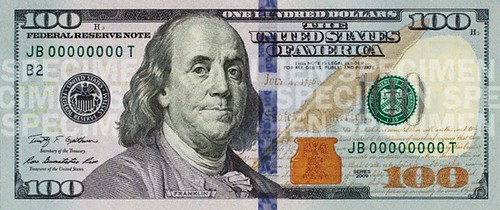
PREV ARTICLE
NEXT ARTICLE
FULL ISSUE
PREV FULL ISSUE
WHERE ARE THE NEW $100 BILLS?
Speaking of U.S. paper money, how come were still waiting for the new $100 bills that were announced ages ago? Still having production problems? This article from Wired magazine takes a look.
-Editor

It’s been nearly three years since the captains of the Federal Reserve, U.S. Treasury, U.S. Secret Service and the Bureau of Engraving and Printing gathered with bankers, journalists and financial security types in the Cash Room at the U.S. Treasury building to unveil the new $100 banknote. The event — pageant, really — received obliging media coverage, but wasn’t exactly page-one material. “Individuals, businesses and governments around the world put their confidence in our currency,” said then-secretary of the Treasury, Timothy Geithner. “They use the dollar because they know that it is backed by the most sophisticated anticounterfeiting technologies known to men, that the design can’t be stolen or replicated.” Geithner was dutifully shoveling it. Making money always has been, and always will be, an endless arms race. Completely outsmarting counterfeiters, like terrorists, is impossible. The security wizardry moves an inch, and counterfeiting soon follows, and on and on. “You know, we just can’t rest,” said Douglas Crane, the vice president of Crane & Co., in a radio interview a few years ago. The Massachusetts-based firm is the Bureau of Engraving and Printing’s sole supplier of the souped-up paper used to make our cash supply. Pressure from counterfeiters is great for Crane’s business. But the new $100 is so high-tech that it has even stymied its progenitor. In December 2010, Bureau officials tersely confessed to a problem: a printing error, affecting as much as $110 billion worth of paper. Taxpayers only paid 12 cents apiece for the faulty notes, or $120 million. That’s not that much money by sovereign-debt standards and provided you’re willing to ignore downstream costs like storing and securing the bad bills, redistributing older-series notes to banks and cash-management firms, investigating and remedying the screwup, determining what to do with the mountain of almost money, and producing vanilla video clips to keep the public informed. The tangled story of the biggest snafu in the history of paper money dates back to 2000, when the Bureau launched its NXG series, starting with the new $20 issued in 2003. The new hundy was going to be the pièce de résistance, produced, in the words of one industry expert, with “the most complex security features ever incorporated into a U.S. banknote.

So when can you have a NextGen Benny? The Fed won’t say. Here’s what we do know. In the summer of 2010, Bureau quality controllers began noticing that bills coming off the massive intaglio presses had a blank sliver due to a crease in the paper. Somehow Crane’s cotton-linen substrate wasn’t staying perfectly flat as it squeezed through the presses, resulting in a small fold. It’s like when you accidentally iron over a fold of a shirt and end up creating a sharp crease.
To read the complete article, see:
The NextGen Benjamins Fiasco
(www.wired.com/business/2013/03/the-nextgen-benjamins-fiasco/all/)
The Numismatic Bibliomania Society is a non-profit organization promoting numismatic literature. See our web site at coinbooks.org. To submit items for publication in The E-Sylum, write to the Editor at this address: whomren@gmail.com To subscribe go to: https://my.binhost.com/lists/listinfo/esylum All Rights Reserved. NBS Home Page Contact the NBS webmaster 
|